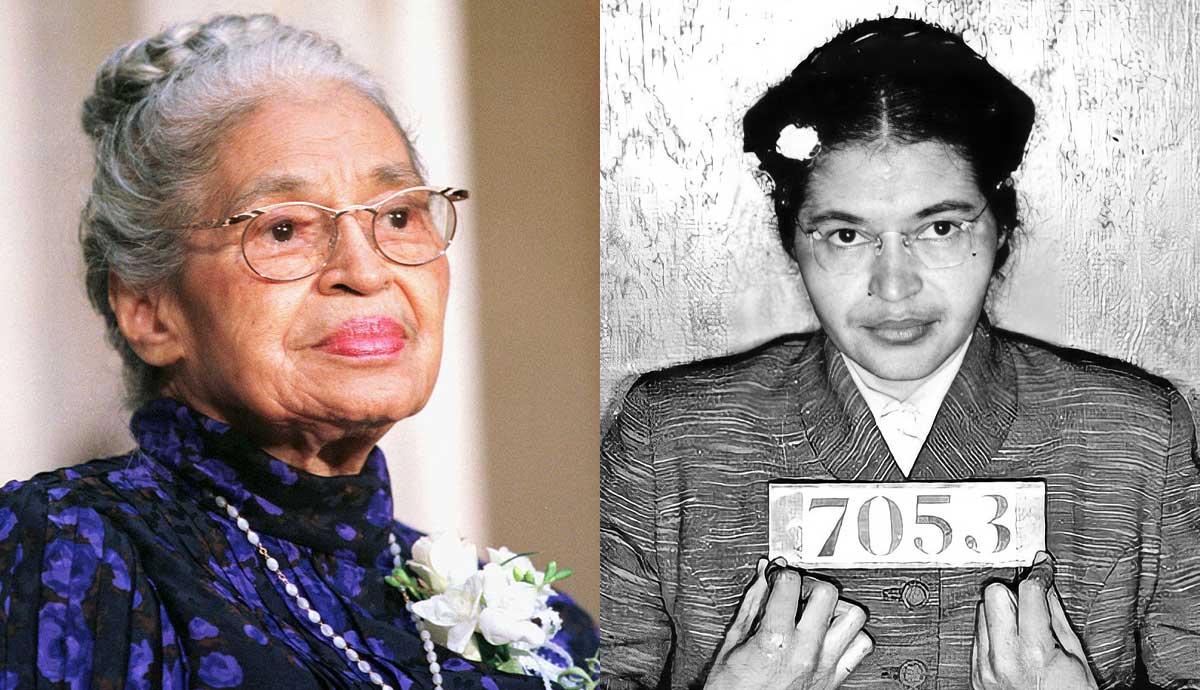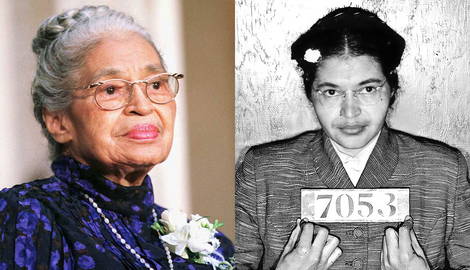
summary
- Rosa Parks was an African American civil rights activist. Her courage in the face of segregation earned her the moniker “mother of the civil rights movement.”
- Bus Incident: In 1955, she refused to give up her bus seat to a white man in Montgomery, Alabama. Her act of defiance led to the Montgomery Bus Boycott.
- The Montgomery Bus Boycott: Rosa Parks was arrested and fined for violating segregation laws, but her act of defiance led to the 381-day Montgomery Bus Boycott. In 1956, the Supreme Court ruled bus segregation unconstitutional.
- Rosa Parks’ Later Years & Legacy: She later moved to Detroit and became and co-founded the Rosa and Raymond Parks Institute for Self-Development in 1987. She was awarded a Congressional Gold Medal in 1999.
- Rosa Parks’ Death: Following her death in 2005, she was laid to rest at the US Capitol.
Rosa Parks was a pioneering Black American civil rights activist who bravely stood up against segregation laws, earning the moniker of “mother of the civil rights movement.” Parks famously refused to give her bus seat to a white man in Montgomery, Alabama, in 1955. This seemingly small act of defiance became the catalyst for the Montgomery Bus Boycott and later the entire civil rights movement across the US. While Parks faced criminal charges and public ridicule in the 1950s, she later became a national symbol of strength and dignity in the long struggle to end racial prejudice.
Rosa Parks Was Born in Tuskegee, Alabama

Rosa Parks was born in Tuskegee in 1913 as Rosa Louise McCauley. Her father was a stonemason and carpenter, and her mother was a teacher. Her parents separated when she was just two years old, and her mother moved Rosa and her younger brother to live on their maternal grandmother’s farm in Pine Level, Alabama, near Montgomery. As a young child, Rosa’s mother home-schooled her and taught her cooking, sewing, and farming skills.
Throughout her childhood, she lived amid constant fear of the Ku Klux Klan, and she remembered hiding behind boarded-shut doors and windows at night. Some nights, she and her brother Sylvester had to sleep in their clothes, just in case they had to make an emergency escape.
She Faced Segregation from a Young Age

As well as facing the fears of overt racism, Rosa Parks grew up with the segregation of Jim Crow laws throughout her adolescence.
Schools for Black children were separate, as were many public facilities, including buses, libraries, restaurants, and drinking fountains. Rosa attended a designated Black high school in Montgomery, followed by a Black teacher’s college. However, she had to leave school when she was 16 as her grandmother became ill.
Rosa Parks’ Husbands & Role in the NAACP

In 1932, at the age of 19, Rosa married Raymond Parks, a barber and long-standing member of the National Association for the Advancement of Colored People (NAACP).
In the same year, encouraged by her husband, she returned to school to continue her education, earning a diploma. She then found work as a seamstress in Montgomery. Both Rosa and her husband became respected, active members of Montgomery’s large African American community.
Rosa Parks joined the National Association for the Advancement of Colored People (NAACP) in 1943 and became the group’s chapter secretary until 1956. There, she worked closely alongside chapter president Edgar Daniel E.D. Nixon, a strong advocate for Black people who wanted to vote.
The Famous Bus Incident

On December 1, 1955, Rosa Parks was riding home on a crowded municipal bus after a long day at work. In these segregated buses, Black people were forced to sit at the back and white people at the front, each with their own designated area.
On this particular day, the white section of the bus was full, so the driver asked the four Black passengers in the front four seats of their section to stand up to make more room for white people. Three of them complied with the request, but Parks refused.
As a result, police arrested Parks for violating segregation laws and handed her a suspended sentence and fine. She later wrote in her biography, “People always say that I didn’t give up my seat because I was tired, but it isn’t true. I was not tired physically… No, the only tired I was, was tired of giving in.”
The Montgomery Bus Boycott

In the ensuing months, Parks became a powerful mascot in the fight against racial segregation. The Black population of Montgomery banded together to form the Montgomery Improvement Association (MIA), with the 26-year-old Martin Luther King Jr. as president.
Together, they staged a 13-month-long series of boycotts and protests against bus segregation, attracting worldwide media attention. As the Black community constituted the majority of the bus company’s ridership, the boycott led to a sharp decrease in its revenue.
Rosa Parks: After the Court Case

During and after her court hearing, Parks faced public bullying and harassment and even lost her job. Eventually, she moved with her family to Detroit, where she became an administrative aide in the Detroit Office of Congressman John Conyers Jr. in 1965 and remained there until her retirement.
Rosa Parks’ Later Years

Throughout her later years, despite facing health and financial troubles, Rosa Parks continued to fight the case for human rights. In 1987, she co-founded the Rosa and Raymond Parks Institute for Self-Development, an organization dedicated to improving the lives of young Black African Americans.
The extent of her philanthropic work is outlined in her biography, Rosa Parks: My Story, published in 1992. In 1999, the United States Congress awarded Parks a Congressional Gold Medal. Following her death in 2005 at the age of 92, Americans further honored her place in history, laying Parks to rest at the US Capitol.
FAQs
Was Rosa Parks the first Black woman to refuse to give up her seat on a bus?
Rosa Parks was not the first Black woman to refuse to give up her seat. Several other women, including Claudette Colvin, had done so before her. However, Parks’s case became the focus of the Civil Rights Movement due to her strong standing in the community and the strategic decision by civil rights leaders to rally around her case.
What was the impact of the Montgomery Bus Boycott?
The Montgomery Bus Boycott was a watershed moment in the Civil Rights Movement. It demonstrated the power of nonviolent resistance and collective action, and it brought national attention to the struggle against racial segregation. The boycott also elevated Martin Luther King Jr., who was a leader of the boycott, to national prominence.
What is Rosa Parks’s legacy?
Rosa Parks’s legacy is one of courage, dignity, and unwavering commitment to justice. Her act of defiance on the bus in Montgomery helped to galvanize the Civil Rights Movement and inspire generations of activists. She is remembered as a symbol of resistance against racial segregation and a champion of equality.











